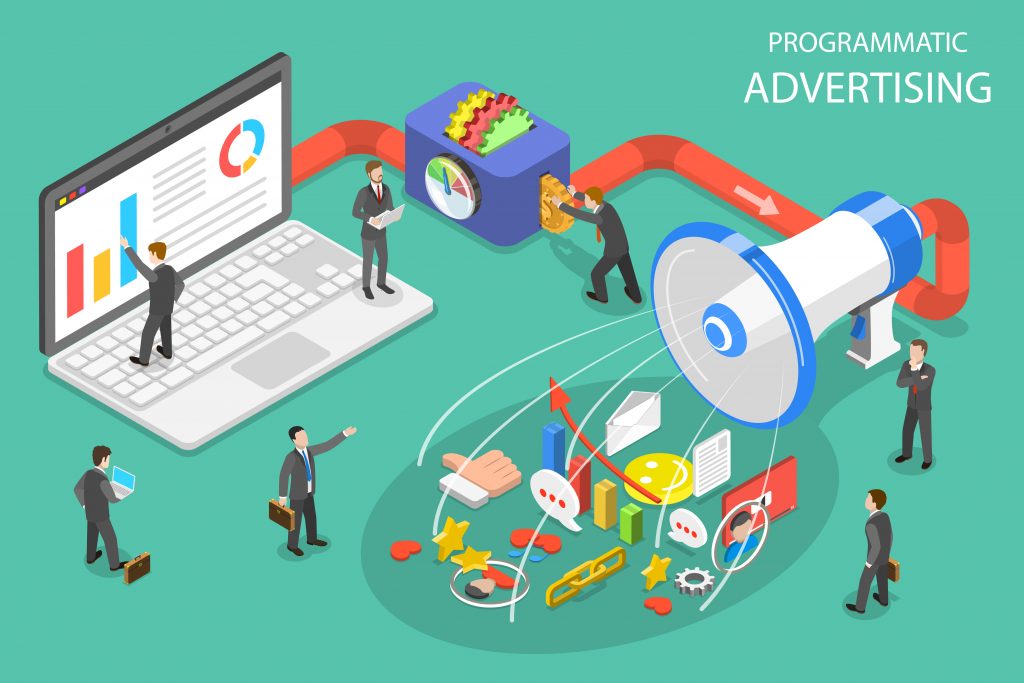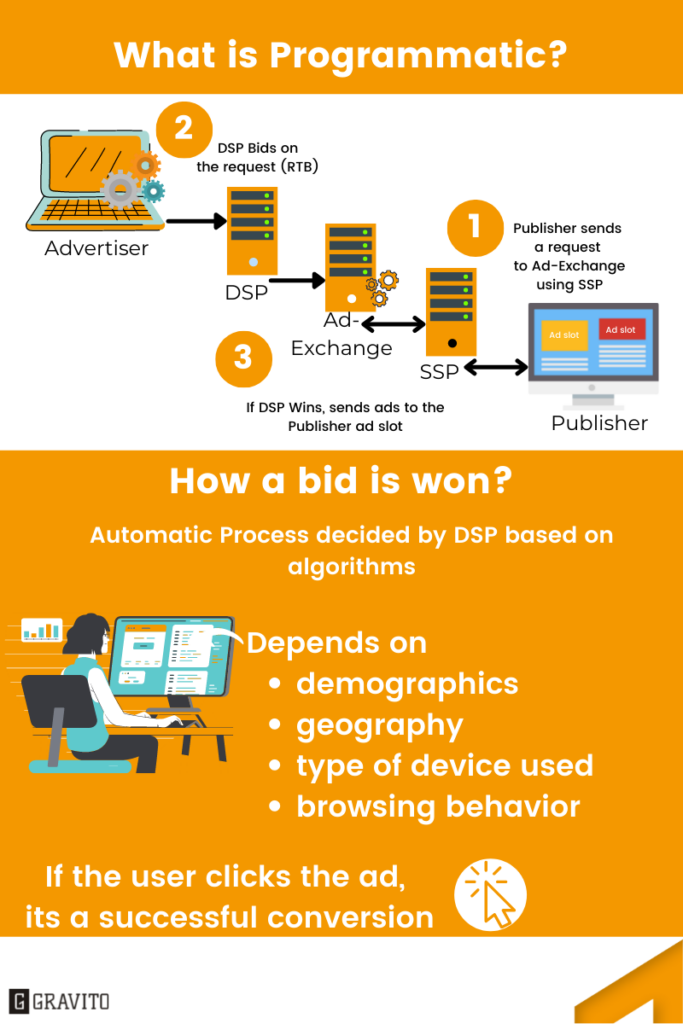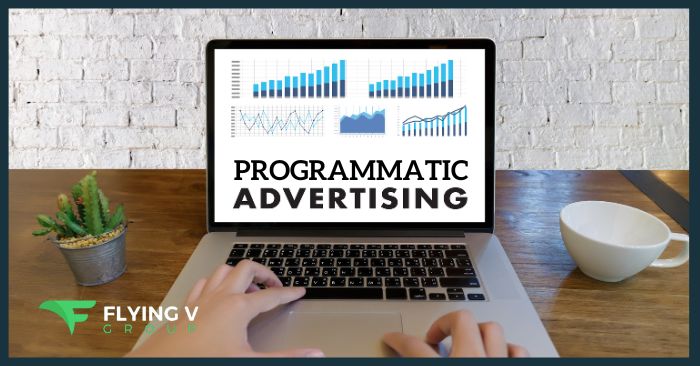
Image from Newor Media
Before diving into the complexities of programmatic audience targeting, it’s essential to have a solid understanding of programmatic advertising as a whole.
Programmatic advertising refers to the automated buying and selling of digital advertising inventory. When a user visits a website or app, the available ad space is instantly evaluated, and advertisers bid to display their ads to that specific user.
Moreover, programmatic audience targeting is a sophisticated digital advertising approach involving automated technologies and algorithms to deliver targeted ads to specific audience segments.
This method relies on data-driven insights and real-time decision-making to optimize ad placements and ensure that the right message reaches the right audience at the right time.
This guide will provide a comprehensive understanding of programmatic audience targeting, including its benefits, types, and various strategies to help you optimize your campaigns.
- Benefits of Programmatic Audience Targeting
- Types of Programmatic Audience Targeting
- Strategies for Effective Programmatic Audience Targeting
- Tools and Resources for Programmatic Audience Targeting
- Future Trends in Programmatic Audience Targeting
- FAQ Section
- 1. What is programmatic audience targeting, and why is it important for digital marketers?
- 2. Is programmatic audience targeting suitable for businesses of all sizes?
- 3. How can businesses measure the success of precision marketing campaigns using programmatic audience targeting?
- 4. How can programmatic audience targeting contribute to a higher return on investment (ROI)?
- 5. Are there specific industries or sectors where programmatic audience targeting is particularly effective?
Benefits of Programmatic Audience Targeting
Programmatic audience targeting offers many benefits for businesses looking to enhance their marketing efforts.
Firstly, it allows for precise targeting, ensuring your ads reach the most relevant audience. By leveraging advanced algorithms and data analysis, programmatic advertising enables you to target users based on their demographics, interests, browsing behavior, and more.
This level of targeting ensures that your ads are seen by those most likely to be interested in your products or services, increasing the chances of conversion.
Programmatic audience targeting also provides unparalleled scalability. Unlike traditional advertising methods, programmatic advertising allows you to reach many potential customers across multiple platforms and devices.
Furthermore, it offers real-time optimization. You can monitor and adjust your campaigns in real time using sophisticated analytics and tracking tools, ensuring you get the most out of your advertising budget.
Types of Programmatic Audience Targeting
With programmatic audience targeting, businesses can employ several key strategies to reach their desired audience effectively. Let’s explore some of the most common types of programmatic audience targeting.
Demographic Targeting
Demographic targeting involves segmenting the audience based on age, gender, income, and education level.
By understanding the demographic makeup of your target audience, you can tailor your ads to resonate with their specific needs and preferences.
Behavioral Targeting
Behavioral targeting focuses on users’ online behavior, such as browsing history, search queries, and content consumption patterns.
Analyzing this data provides insights into users’ interests and preferences, allowing you to deliver highly relevant ads.
For instance, if a user has recently searched for hiking gear, you can serve them ads for outdoor equipment or adventure travel packages.
Contextual Targeting
Contextual targeting involves placing ads on websites or apps with content related to your products or services.
This strategy relies on analyzing the content of a webpage or app to determine its relevance to your target audience.
For instance, if you’re a sports apparel brand, you may display your ads on websites or apps related to fitness and sports.
Geo-Targeting
Geo-targeting allows you to target users based on their geographic location. This strategy benefits businesses with a physical presence or those looking to target specific markets.
For example, if you operate a chain of coffee shops, you may want to target users within a certain radius of your locations.
Strategies for Effective Programmatic Audience Targeting

Image from Gravito
Now that we’ve explored the different types of programmatic audience targeting let’s delve into some strategies that can help you optimize your campaigns for maximum effectiveness.
Define Your Target Audience
Defining your target audience is crucial before launching any programmatic audience targeting campaign.
Start by analyzing your existing customer base and identifying common characteristics, such as demographics, interests, and behaviors, to help you create highly relevant and compelling ads.
Leverage First-Party Data
First-party data refers to the data collected directly from your audience, such as website analytics, customer surveys, and purchase history.
Leveraging first-party data allows you to gain deeper insights into your audience’s preferences and behaviors, enabling you to deliver more personalized and targeted ads.
Additionally, using first-party data ensures that your targeting is based on accurate and reliable information.
Incorporate Third-Party Data
While first-party data provides valuable insights, incorporating third-party data can further enhance your targeting capabilities.
External sources collect third-party data and can provide additional information about your target audience, such as browsing behavior or offline purchase history.
You can create a comprehensive audience profile and deliver highly tailored ads by combining first-party and third-party data.
Test and Optimize
Testing and optimization are crucial components of any successful programmatic audience targeting campaign.
Continuously monitor your campaign’s performance and analyze key metrics, such as click-through rates, conversion rates, and return on ad spend.
Identify underperforming ads or targeting strategies and make data-driven adjustments to improve their effectiveness.
Establish Frequency Caps
It’s essential to establish frequency caps to avoid ad fatigue. Ad fatigue occurs when users are repeatedly exposed to the same ad, leading to decreased engagement and conversion rates.
By setting frequency caps, you can control the number of times a user sees your ad within a specific period, ensuring your message remains fresh and impactful.
Tools and Resources for Programmatic Audience Targeting
To effectively implement programmatic audience targeting, leverage the following tools and resources:
Demand-Side Platforms (DSPs)
Demand-side platforms (DSPs) are software platforms that help advertisers manage and optimize programmatic ad campaigns.
DSPs provide access to ad inventory across multiple ad exchanges, allowing advertisers to reach their target audience efficiently. Popular DSPs include Google Display & Video 360, The Trade Desk, and MediaMath.
Data Management Platforms (DMPs)
Data Management Platforms (DMPs) help businesses collect, organize, and analyze audience data.
DMPs enable you to create comprehensive audience profiles, segment your audience, and activate your data for programmatic advertising. Some leading DMPs include Adobe Audience Manager, BlueKai, and Krux.
Ad Verification and Brand Safety Tools
These tools ensure your ads are displayed in brand-safe environments and are not associated with objectionable content.
These tools allow you to address any potential brand safety issues proactively. Examples of ad verification and brand safety tools include Integral Ad Science, DoubleVerify, and MOAT.
Analytics and Reporting Platforms
These platforms allow you to track and measure the performance of your programmatic audience-targeting campaigns.
They provide valuable insights into key metrics, such as impressions, clicks, conversions, and return on ad spend. Popular analytics and reporting platforms include Google Analytics, Adobe Analytics, and Tableau.
Future Trends in Programmatic Audience Targeting
In a world where audience relevance is paramount, programmatic audience targeting emerges as a tool and a strategic imperative.
It empowers brands to deliver the right message to the right audience at the right moment, reshaping digital advertising for unparalleled success.
Moreover, its flexibility allows for continual optimization, ensuring campaigns remain effective and adaptive to changing market conditions.
Future developments promise more precise targeting, ethical data practices, and engaging ad experiences that resonate with the ever-evolving expectations of today’s digital consumers.
By embracing the various types of this targeting strategy, advertisers can craft campaigns that resonate with users profoundly, enhancing engagement and driving conversions.
FAQ Section
1. What is programmatic audience targeting, and why is it important for digital marketers?
Programmatic audience targeting is a digital advertising strategy that utilizes automated technology to deliver personalized and relevant content to specific audiences. It is crucial for marketers as it enhances precision, efficiency, and effectiveness in reaching and engaging target audiences.
2. Is programmatic audience targeting suitable for businesses of all sizes?
Yes, programmatic audience targeting is scalable and adaptable, making it suitable for businesses of all sizes. Small businesses can benefit from its efficiency, while larger enterprises can leverage its capabilities for more extensive and complex campaigns.
3. How can businesses measure the success of precision marketing campaigns using programmatic audience targeting?
Several KPIs can be used to measure success. These indicators include the click-through rate, which measures the number of clicks on a particular advertisement; the conversion rate, which measures the percentage of visitors who take a desired action, and the engagement metrics, which measure how actively users interact with a particular advertisement. By monitoring these metrics, you can gain valuable insights into the effectiveness of their campaigns and make data-driven decisions to optimize their performance and achieve better results.
4. How can programmatic audience targeting contribute to a higher return on investment (ROI)?
Programmatic audience targeting contributes to higher ROI by ensuring ad spend is directed towards the most relevant audience segments, reducing wastage and increasing the likelihood of conversions.
5. Are there specific industries or sectors where programmatic audience targeting is particularly effective?
While programmatic audience targeting benefits various industries, those with specific target audience segments and diverse customer profiles often see significant benefits. Industries such as e-commerce, retail, and finance can leverage programmatic audience targeting to tailor campaigns to the unique needs of their audiences.






0 Comments